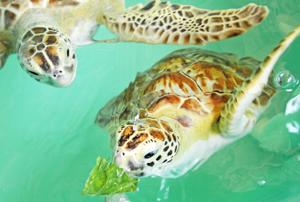Five turtles in the care of Sea Turtle Inc. took a trip to the mid-Valley earlier this week in hopes that CT scans will reveal more about their medical conditions and point to potential treatments. Licensed Veterinary Technician Nina Nahvi said the turtles are doing well, and the center is awaiting the results. Tom de Maar, senior veterinarian at Gladys Porter Zoo, is attending veterinarian at Sea Turtle Inc. and will determine the best way to care for the turtles. Caretakers took the turtles Sunday to Texas Health Care Imaging in Weslaco, which performed the scans for free, she said. It’s the third time Sea Turtle Inc. has used CT scans to learn more about its turtles’ ailments. Nahvi said that while sea turtles can live outside water for weeks at a time, staff try to limit that because it can be uncomfortable and stressful for them. Their trip to get the scans took about four hours, she said. Two of the green sea turtles, Reveille and Tyler Durden, suffer from a disease called fibropapilloma that causes tumors on exterior soft tissue, she said. The CT scans will help determine if they also have internal tumors, which are difficult to see on X-rays. Nahvi said the disease is caused by a virus that is similar to herpes in humans and can cause tumors to grow on turtles’ flippers and around their eyes. It affects mostly green sea turtles and is believed to be tied to water quality or pollution, she added, and it occurs worldwide. De Maar removes the tumors with a surgical laser, Nahvi said, but they grow again in the same area. “It’s almost like we’re putting a bandage on it, but we’re doing the best we can,” she said. Sea Turtle Inc. has partnered with the University of Texas Rio Grande Valley on research into the disease that hopefully will lead to a treatment, she added. Reveille was not in the mood to cooperate during the CT scan appointment even after being given a sedative, and Nahvi said the turtle had to be swaddled like a baby to get the scan done. “You can’t just tell a turtle to sit still, unfortunately,” she said. Another green sea turtle, Verde, was left unable to use her back flippers due to spinal injuries after being struck by a boat, Nahvi said, which has also caused buoyancy issues. It’s unlikely that Verde will be able to be released, she said, because the turtle can’t dive for food and is at risk of getting hit by another boat. However, the CT scan will show the severity of those injuries and help Sea Turtle Inc. staffers learn the root of Verde’s buoyancy problems, Nahvi said. It’s also unclear why Great Scott, a green sea turtle, and Leo, a hawksbill turtle, have buoyancy problems, Nahvi said, though she’s hopeful the CT scans will provide more information on the cause. Bloodwork and X-ray scans so far haven’t answered that question. “There’s got to be a reason why,” she said, adding that pneumonia, gastrointestinal tract or congenital problems are possible causes. The CT scans are being done by a specialist with Animal Imaging in Dallas, Nahvi said, and are expected to be given to Sea Turtle Inc. soon.
NADIA TAMEZ-ROBLEDO, Staff Writer





